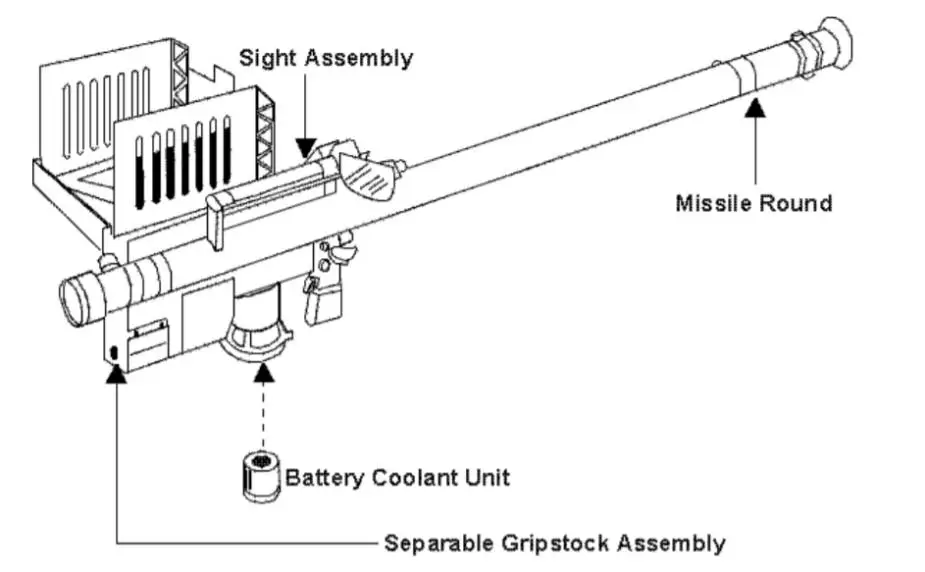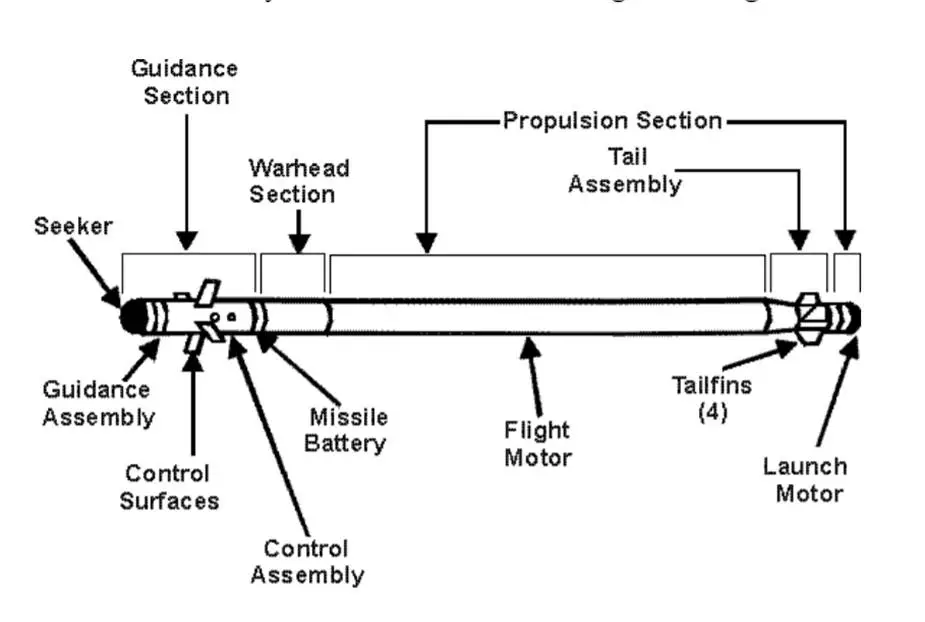- Army
- Air Defense Systems
- Anti-tank systems and vehicles
- Armored Vehicles
- Armoured personnel carriers
- Artillery Vehicles and Weapons
- Command Post
- Communication Vehicles and Systems
- Electronic Warfare
- Engineer | Maintenance Vehicles
- Infantry Fighting Vehicles
- Main Battle Tanks
- Missiles
- Tactical and Logistic Vehicles
- Radars
- Unmanned Systems
- Weapons
- Navy
- Air
FIM-92 Stinger
Stinger FIM-92 MANPADS
Man-portable surface-to-air defense missile system - United States

Description
The FIM-92 Stinger is a man-portable surface-to-air missile system (MANPADS) that was designed and manufactured by the American Defense Industry. The Stinger was the successor to the Redeye Weapon System, the Stinger missile provides forward, short-range air defense against low-altitude airborne targets. The system enters into service with the U.S. Army in 1981. Used currently by the United States armed forces and 29 other countries, it is manufactured by Raytheon Missile Systems and under license by EADS in Germany. The Stinger Weapon System provides superior air defense for today's highly mobile forces. Stinger has been combat-proven in four major conflicts and has over 270 fixed-wing and rotary-wing kills to its credit. Stinger-RMP is a lightweight, self-contained air defense system that can be rapidly deployed on military platforms in any combat situation. Stinger-RMP (Reprogrammable Microprocessor) missiles are used interchangeably, on helicopters for air-to-air self-defense teams for surface-to-air engagements. Immediately after launch, the gunner is free to take cover to engage additional targets, thereby maximizing his survivability and combat effectiveness.
Stinger FIM-92 MANPADS main variants:
- FIM-92A: first version
- FIM-92C: Stinger RMP: The resistance to interference was increased again by adding more powerful digital computer components. Moreover, the software of the missile could now be reconfigured in a short time in order to respond quickly and efficiently to new types of countermeasures. Until 1991, some 20,000 units were produced for the U.S. Army alone.
- FIM-92D: Various modifications were continued with this version in order to increase the resistance to interference.
- FIM-92E: Stinger - RMP Block I: By adding a new rollover sensor and revised control software, the flight behavior was significantly improved. Additionally, the performance against small targets such as drones, cruise missiles, and light reconnaissance helicopters was improved. The first deliveries began in 1995. Almost the entire stock of U.S. Stinger missiles was replaced by this version.
- FIM-92F: A further improvement of the E-version and the current production version.
- FIM-92G: An unspecified upgrade for the D variant.
- FIM-92H: Indicates a D-variant that has been upgraded to the E standard.
- FIM-92I: Stinger - RMP Block II: This variant was planned developed based on the E version. The improvements included an imaging infrared seeker head from the AIM-9X. With this modification, the detection distance and the resistance to jamming were to be greatly increased. Changes to the airframe would furthermore enable a significant increase in range. Although the missile reached the testing phase, the program was dropped in 2002 for budgetary reasons.
- FIM-92J: Block 1 missile upgrade to replace aging components to extend service life an additional 10 years. The warhead is also equipped with a proximity fuse to increase effectiveness against unmanned aerial vehicles.
- ADSM, Air Defence Missile Suppression: A variant with an additional passive radar seeker, this variant can also be used against radar wave transmitters.
Technical Data
| Launcher Unit |
|
The FIM-92 Stinger missile launch unit contains the AIM-92 missile. The Stinger weapon round is shipped from the ammunition supply point in a crush-resistant, hardened, reusable aluminum box. It is certified for immediate firing. This box is called the weapon round container but is more commonly referred to as a mono box. Stinger rounds are packaged in a thin, woodside box surrounding a foam insert in which the missile is packed. The boxes are known as “lettuce crates” because of their similarity to produce boxes. The Stinger weapon round consists of a missile round, a separable gripstock assembly, and up to three battery coolant units (BCUs). The gripstocks are shipped separately from the missile to enhance security during shipping.
|
 |
| Missile |
|
The "fire-and-forget" Stinger FIM-92 missile employs a passive infrared seeker to home in on its airborne target. A passive infrared seeker emits no radiation that a target aircraft can detect, and, instead, guides on the infrared energy (heat) emitted by the target. Because the Stinger employs a passive homing seeker, it is a "fire-and-forget" weapon that needs no guidance from the operator after firing, unlike other missiles that track the reflection of a designator beam, requiring the operator to maintain a lock on the target. This allows a Stinger operator to take cover, relocate, or engage other targets immediately after firing a Stinger. The missile is 1.52 m long and 70 mm in diameter with 10 cm fins. The missile itself weighs 10.1 kg while the missile with launcher weighs approximately 15.2 kg. The Stinger is launched by a small ejection motor that pushes it a safe distance from the operator before engaging the main two-stage solid-fuel sustainer, which accelerates it to a maximum speed of Mach 2.2 (750 m/s). The warhead is a 3 kg penetrating hit-to-kill warhead type with an impact fuze and a self-destruct timer. The warhead section consists of a fuze assembly and the equivalent of one pound of high explosives encased in a pyrophoric titanium cylinder. The fuze is extremely safe and makes the missile exempt from any hazards of electromagnetic radiation to ordnance conditions. The warhead can be detonated by penetrating the target, impacting the target, or self-destruction. Self-destruction occurs 15 to 19 seconds after launch. The "fire-and-forget" Stinger FIM-92 missile employs a passive infrared seeker to home in on its airborne target. A passive infrared seeker emits no radiation that a target aircraft can detect, and, instead, guides on the infrared energy (heat) emitted by the target. The Stinger missile itself has an outward targeting range of up to 4,800 m (15,700 feet) and can engage low-altitude enemy threats at up to 3,800m (12,500 feet).
|
 |
| Components |
| The AN/PAS-18 is a rugged, lightweight thermal imaging sight that mounts on the Stinger weapon round to provide a 24-hour mission capability. The unit is designed to detect both fixed-wing and rotary-wing aircraft beyond the maximum range of the Stinger missile. The primary function of the AN/PAS-18 is to enhance the operation of the Stinger missile system. It operates in the same region of the electromagnetic spectrum as the Stinger missile and detects any infrared source the missile can detect. This capability also allows a secondary function of night area surveillance. Operating passively in the infrared spectrum, the AN/PAS-18 allows the gunner to perform target acquisition and weapon firing during total darkness and under reduced visibility conditions (e.g., fog, dust, and smoke). In a clear sky environment, day or night, the AN/PAS-18 can detect fixed-wing aircraft at high altitudes in a tail aspect to the horizon. In optimal conditions, detection can be in excess of 20 to 30 kilometers. The AN/PAS-18 is least effective in detecting fixed-wing aircraft at low altitudes coming directly toward the operator. As the exhaust plume is hidden by the body of the aircraft, the aircraft may not be detected until it is within 8 to 10 kilometers of the operator. The detection range increases when an aircraft’s aspect changes, providing a view of the plume (side aspect to rear aspect). The AN/PAS-18 has a 12 by 20° field of view. It is ready for operation within 10 seconds of powering up. The receiver is powered by a lithium battery that provides 6 to 12 hours of battery life. The AN/PAS-18 is a second-generation night vision device and does not have the resolution to make aircraft identification determinations. Due to bulk of the device, long periods of searching and scanning should be avoided. The weight of the night sight and the missile reduces the time a gunner can shoulder the weapon. |
| Combat use |
| Light to carry and easy to operate, the FIM-92 Stinger is a passive surface-to-air missile, shoulder-fired by a single operator, although officially it requires two. The FIM-92B missile can also be fired from the M-1097 Avenger and M6 Linebacker. The missile is also capable of being deployed from a Humvee Stinger rack, and can be used by paratroopers. A helicopter launched version exists called Air-to-Air Stinger (ATAS). To fire the weapon, the soldier aims the missile at the target. When the seeker locks on, it makes a distinctive noise. The Stinger missile can hit targets flying of 3,500 m and has a firing range of around 8 km. Stinger missiles use passive IR/UV sensors. The missiles look for the infrared light (heat) produced by the target airplane's engines and track the airplane by following that light. The missiles also identify the UV "shadow" of the target and use that identification to distinguish the target from other heat-producing objects. |
Specifications
| Type | Size missile |
| Man-portable surface-to-air missile system (MANPADS) | Length: 1.52m Diameter: 140mm |
| Country users | Missile Weight |
| Bangladesh, Chad, Chile, Denmark, Germany, Greece, India, Iraq, Israel, Italy, Japan, Lithuania, Morocco, Netherlands, Norway, Pakistan, Portugal, Saudi Arabia, Slovenia, South Korea, Switzerland, Taiwan, Turkey, Ukraine, United Kingdom, United States | 10.1 kg |
| Designer Country | Range missile |
| United States | 1,000 to 8,000 m |
| Missile type | Weight launch unit |
| Infrared homing surface-to-air missile | 15.2 kg |
| Operators | Altitude missile |
| 2 | 3,000 m |
Details View
 |
 |
Pictures - Video



























